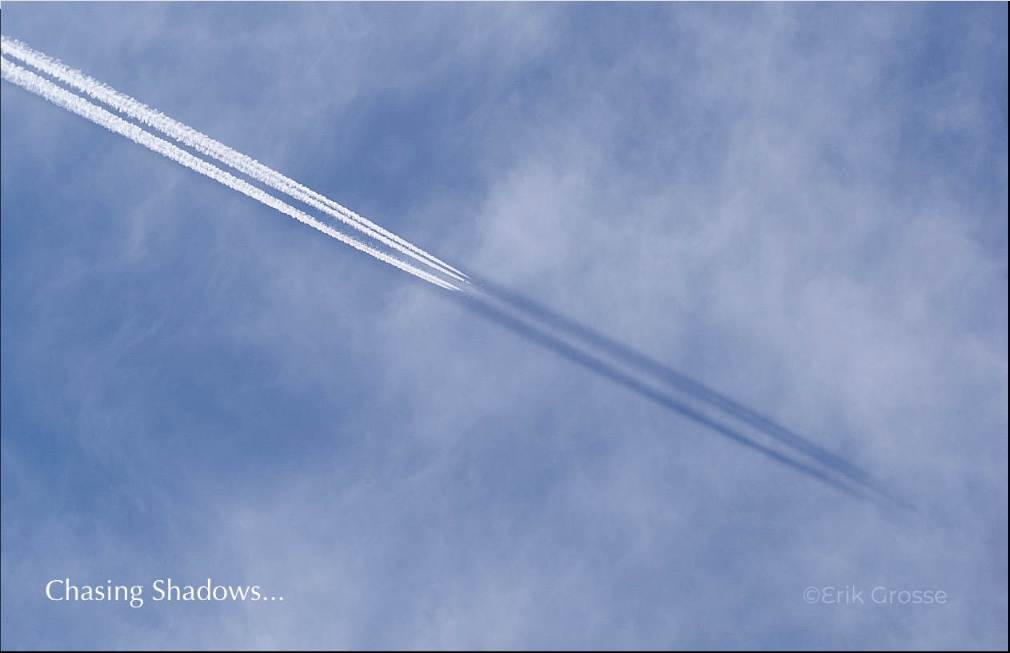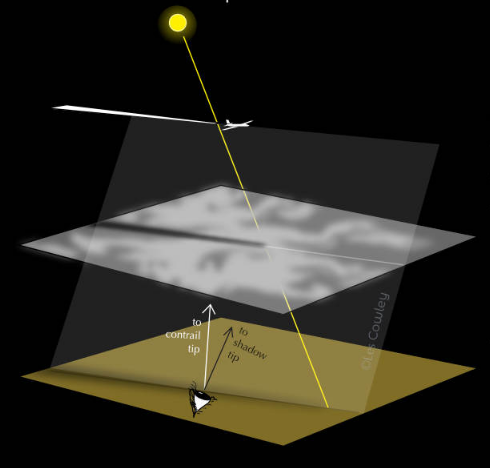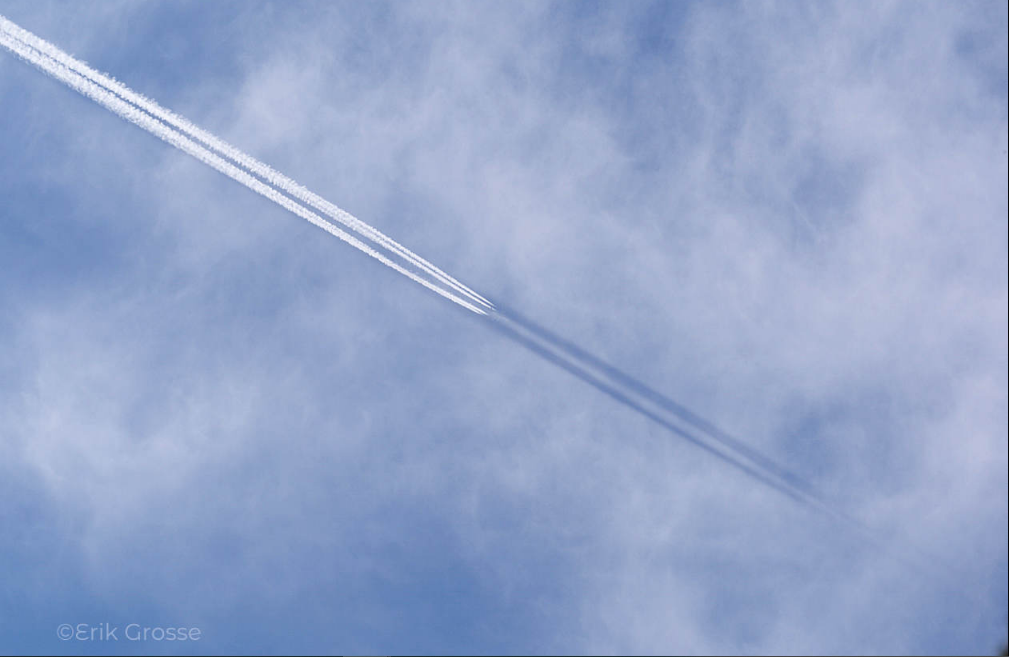Contrail chasing its shadow across the sky
Contrail Chasing its Shadow Across the Sky: Exploring the Phenomenon
Have you ever looked up at the sky and noticed a contrail seemingly chasing its own shadow? It's a fascinating sight that often leaves us with questions. In this article, we'll delve into the science behind this intriguing atmospheric optics phenomenon and uncover the reasons behind its occurrence.
Contrails, short for "condensation trails," are formed when hot exhaust gases from aircraft engines mix with the cold air in the upper atmosphere. This interaction causes the water vapor in the exhaust to condense into tiny ice crystals, forming visible trails behind the aircraft. These contrails can persist for varying lengths of time depending on atmospheric conditions.
Now, let's address the main question: why is the contrail almost exactly in-line with its shadow, and why does the shadow appear to lead? The answer lies in the unique geometry that occurs when the aircraft or its contrail appears to cross the sun.
To understand this phenomenon, we need to consider the path of sunlight and the position of the observer. Despite the sun being approximately 93 million miles away, its rays appear almost parallel in our local sky and travel downwards towards the Earth's surface.
When a contrail is formed, it casts a shadow onto a lower layer of translucent cloud. From our vantage point below, we perceive this darkened cloud as the shadow of the contrail. However, it's important to note that all contrail shadows are counter-intuitive. They seem to be above the contrail, seemingly cast upwards from a sun near the ground. This optical illusion can be perplexing.
The reason behind this illusion lies in the intersecting planes of the contrail, its shadow, and our line of sight. To observe the contrail crossing the sun and seemingly chasing its shadow, a sloping grey plane must intersect both the contrail line and the line of its shadow on the lower cloud. This alignment creates the illusion of the contrail and its shadow being in-line.
But what about the shadow leading the contrail? In this case, the aircraft must have already crossed the sun. However, it's important to note that there are exceptions to this rule. When the sun is at the horizon, atmospheric refraction can cause some rays to travel slightly upwards relative to the local horizontal, leading to variations in the phenomenon.
To summarize the key points:
- Contrails are formed when hot exhaust gases mix with cold air in the upper atmosphere, causing water vapor to condense into ice crystals.
- The contrail appears to be in-line with its shadow when it crosses the path of the sun.
- Contrail shadows are counter-intuitive and seem to be above the contrail, casting upwards from a sun near the ground.
- The contrail shadow is cast onto a lower layer of translucent cloud, which we perceive as a darkened cloud from below.
- To observe the contrail chasing its shadow, there must be an intersection between the sloping grey plane, the contrail line, and the line of its shadow on the lower cloud.
- The shadow leading the contrail occurs when the aircraft has already crossed the path of the sun, although atmospheric refraction can cause variations in this phenomenon when the sun is at the horizon.
Next time you spot a contrail chasing its shadow across the sky, take a moment to appreciate the intricate interplay between light, clouds, and aircraft. It serves as a reminder of the wonders of atmospheric optics and the captivating beauty that can be found in our everyday surroundings.

Erik Grosse at Ulm in Germany pictured this contrail chasing its shadow. A UPS freight 747 flying from Dubai to Cologne at 34,000ft was responsible. Each of its four engines left a distinct trail of condensed water droplets.
Why are the contrail and the shadow almost exactly in-line? Why does the shadow lead? The special geometry that is needed only happens when we see the aircraft or its contrail appear to
cross the sun.

All contrail shadows are counter-intuitive. To the eye and in photos the shadow seems to be above the contrail. Cast upwards from a sun near the ground! But the sun is around 93 million
miles away, its rays in our local sky are almost parallel and they travel downwards...
The contrail shadow is cast onto a lower level layer of translucent cloud. We see the darkened cloud from below. Now comes the headachy bit. Imagine the sloping grey plane at left. It passes across the contrail line and the line of its shadow on the lower cloud. To have the contrail cross the sun and chase its shadow the grey plane must also intersect your eye.
To have the shadow leading the contrail, the aircraft must already have crossed the sun.
..To be pedantic, not quite always. When the sun is at the horizon, atmospheric refraction can cause some rays to travel slightly upwards relative to your local horizontal.

Note: this article has been automatically converted from the old site and may not appear as intended. You can find the original article here.
Reference Atmospheric Optics
If you use any of the definitions, information, or data presented on Atmospheric Optics, please copy the link or reference below to properly credit us as the reference source. Thank you!
-
<a href="https://atoptics.co.uk/blog/contrail-chasing-its-shadow-across-the-sky/">Contrail chasing its shadow across the sky</a>
-
"Contrail chasing its shadow across the sky". Atmospheric Optics. Accessed on April 23, 2024. https://atoptics.co.uk/blog/contrail-chasing-its-shadow-across-the-sky/.
-
"Contrail chasing its shadow across the sky". Atmospheric Optics, https://atoptics.co.uk/blog/contrail-chasing-its-shadow-across-the-sky/. Accessed 23 April, 2024
-
Contrail chasing its shadow across the sky. Atmospheric Optics. Retrieved from https://atoptics.co.uk/blog/contrail-chasing-its-shadow-across-the-sky/.